Decoding the effect of defect and domain on piezoelectric properties of K0.5Na0.5NbO3-based single crystals
IF 3.5
2区 物理与天体物理
Q2 PHYSICS, APPLIED
引用次数: 0
Abstract
The ultra-high piezoelectric activity of K0.5Na0.5NbO3 (KNN)-based single crystals with excellent electromechanical coupling characteristics has attracted great interest. However, the growth of KNN-based single crystals is restricted by their high melting point and harsh equipment conditions. In this work, a large-sized single crystal of (K0.5Na0.5)0.994Bi0.006Nb0.998Cu0.004O3 (KNNBC) was grown using an inexpensive and simple seed-free solid state crystal growth method. The growth mechanism, domain structures, defects, piezoelectric properties, as well as the conduction mechanisms of the KNNBC single crystal were systematically investigated. A significant piezoelectric coefficient (d33) as high as 392 pC/N is obtained in the KNNBC single crystal, which is three times higher than that of ceramics with the same composition, and the single crystal also maintains a high Curie temperature (Tc ∼ 399 °C). The superior piezoelectric properties are believed to stem from the ordered arrangement of large-sized striped domains (∼300 nm) and the sensitivity to polarization rotation due to the flattening of the Landau energy density. Additionally, the spontaneous polarization combined with complex defect dipoles consisting of Cu2+ ions and O2− vacancies effectively modulates both the quality factor (Qm) and the piezoelectric coefficient (d33) of the single crystals. This work broadens the growth strategy of high-performance KNN-based single crystals and highlights the great benefits of the synergistic modulation of defects and domains on the piezoelectric properties of single crystals.求助全文
约1分钟内获得全文
求助全文
来源期刊

Applied Physics Letters
物理-物理:应用
CiteScore
6.40
自引率
10.00%
发文量
1821
审稿时长
1.6 months
期刊介绍:
Applied Physics Letters (APL) features concise, up-to-date reports on significant new findings in applied physics. Emphasizing rapid dissemination of key data and new physical insights, APL offers prompt publication of new experimental and theoretical papers reporting applications of physics phenomena to all branches of science, engineering, and modern technology.
In addition to regular articles, the journal also publishes invited Fast Track, Perspectives, and in-depth Editorials which report on cutting-edge areas in applied physics.
APL Perspectives are forward-looking invited letters which highlight recent developments or discoveries. Emphasis is placed on very recent developments, potentially disruptive technologies, open questions and possible solutions. They also include a mini-roadmap detailing where the community should direct efforts in order for the phenomena to be viable for application and the challenges associated with meeting that performance threshold. Perspectives are characterized by personal viewpoints and opinions of recognized experts in the field.
Fast Track articles are invited original research articles that report results that are particularly novel and important or provide a significant advancement in an emerging field. Because of the urgency and scientific importance of the work, the peer review process is accelerated. If, during the review process, it becomes apparent that the paper does not meet the Fast Track criterion, it is returned to a normal track.
 求助内容:
求助内容: 应助结果提醒方式:
应助结果提醒方式:


